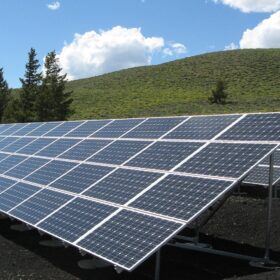pv magazine: Tell us a little about Husk Power Systems and its mini-grid system.
Manoj Sinha: The company was founded in 2008 in the state of Bihar in India. As one of the co-founders, the idea was to tackle the electricity problem in Bihar, which at that time 60-70% population did not have access to electricity or even an unreliable power supply. We started with a mini-grid concept, which was new to India at that time. The mini-grid is a decentralized power plant system with a distribution network that runs roughly 2 km in each direction from the power plant to connect residential and small business units.
First, we tried to explore solar power. However, in 2008 solar was quite expensive, with costs around $5-6/W. Now it is around $0.35/W. Therefore, we ended up choosing downdraft biomass gasification technology that uses rice husk as a feedstock to generate power. We equipped the system with smart metering, and as this was a success it gave us the confidence to spread across Indian and potentially around the globe.
This growth allowed us to a raise some amount of financing in 2010. We expanded our footprint to more than 10,000 customers by 2013. However, as customers became aspirational, 6-8 hours of electricity was no longer sufficient, not like it was in 2010-11. This brought a significant shift in our business model.
In 2013, as solar prices came down to around $1/W, this compelled us to use PV. In 2014, we partnered with First Solar to launch our new product, called the hybrid mini-grid system. By utilizing solar PV for daytime supply and biomass gasification f from 5 p.m. to midnight, and with a battery backup that takes over from midnight until dawn, we could enable 24×7 power.
For non-sunny days, we designed biomass as a base load provider and launched this new feature in 2015 with the smart prepaid metering system, where users can top up the money in advance, and expenses will be deducted according to their usage.
We have since received new capital investment from strategic investors Shell and Engie. This will help us to expand more rapidly both in India and Africa, where we are currently working in Tanzania with a similar framework.
How important is storage for the energy sector in the next five years?
There are a lot of research activities and money going into the storage. Storage is a very critical asset for a mini-grid system because it provides stability from two perspectives. First, in cloudy weather, where solar irradiation drops, your grid may trip if you do not fulfill the demand. Second, during the night time when there is no sun, storage proves its worth.
In our mini-grid case, a biomass gasification system is necessary because of base load supply, which I think will not go away, and because in villages the night time demand is high compared to daytime demand.
Hence, Storage is crucial in that sense, but, if you are forced to use storage today, it will be unaffordable. However, storage is more accessible to operate and more manageable when compared to a moving system, which is biomass in our case and diesel genset for others.
But I believe that storage prices must fall a further 50% to become mainstream, from both a grid perspective and also from a mini-grid perspective. At the current cost, we will not be able to pass on that cost to the customers, when they are using it the most between 5 p.m. and midnight. This is where biomass suits customers, and us. That is our thought process from the cost perspective.
If talking about longevity, the actual lifetime of a lead acid battery in the field, not in the datasheet, is 1,500-1,800 cycles, approximately 4-5 years. Ideally, when installing solar, we consider 18-20 years as the life of PV plant. Therefore, storage equipment should at least match that, or half of that, reaching a minimum 10 year cycles. Otherwise, as a grid supplier, we will be running around every year to replace empty battery banks.
You are planning 300 mini-grids in Indian and Tanzania. Can you reveal more details about these projects?
In India we are focusing on two states, Uttar Pradesh (UP) and Bihar. The first reason is that UP has a well-defined mini-grid policy, so we are protected by the policy that is already in place. Bihar also has policies that they have talked about but not fully implemented. Secondly, according to Ministry of Power data, the rural areas in these states are still only 50% electrified, and villages are even more under electrified. So just between these two states, we have 100+ million people without access to reliable electricity in India. So that gives us a pretty large market to enter.
Therefore, we are planning to install 250-300 mini grid sites over the next 3-4 years in India. We will be doing 50-100 new sites in Tanzania, over the same duration of time.
In Tanzania, it is more sensible because the villages there are more spread out, so the cost of expanding the main grid beyond 7 km is more expensive than our entire power plant and distribution network.
Along with that, we will be working with regulators and DISCOMs, to enable all of us to meet the 100% electricity goal.
This model has been tested in cities, where DISCOMs have distributed the energy sourced from outside the city. However, it needs to be done in rural areas as well, where we can efficiently produce and distribute the electricity.
How much solar is involved in your mini-grid plan?
We have two power generating sources: solar and biomass gasification provide 50% each. Roughly, regarding capacity for each mini-grid, it is 30 kW of solar PV and 30 kW of biomass gasification. This is how a typical configuration looks at each hybrid mini-grid site. Furthermore, this system can serve 200 to 300 customers with 24×7 power supply.
What battery type are you using?
We have been using lead-acid maintenance free VRLA. This technology has shown good LCOE. From one of the first few sites, which was completed three years ago, there have been no reported problems. So far, based on pricing and maintenance, lead-acid seems to be most appropriate chemistry for us.
We have spoken with vendors of lithium-ion technology, but none have been able to demonstrate that their LCOE is lower than lead acid. One thinks that a lot of people do think this; they demonstrate excel sheets based on the datasheet available from vendors. However, such datasheets are available at 20-25°C. In our case, we never see that temperature band, other than during winter months. Li-ion battery degrades extremely fast at high temperatures, and in summer temperatures in India and Tanzania often reach above 40°C.
Until now, I have not seen a practical analysis where somebody can prove that Li-ion LCOE is lower than lead-acid. We have also explored redox flow batteries, but there we have faced two main challenges. First, we are a small company, so cannot always invest in the best quality with excellent longevity; we are restricted from that perspective. Second, such flow batteries are expensive, and upfront CAPEX is incredibly high compared to lead-acid.
How are you penetrating Indian market, which is cost-sensitive? How affordable will these systems be for rural households?
Yes, you are right, but that is also true for customers everywhere. However, Indians are more aggressive regarding pricing or cost-sensitivity. For our customer, we compare our offering with the main alternatives. Those being a diesel genset power supply, or their solar home system, which comprises a single panel plus battery. The system expense for us is anywhere between 25-50% lower than whatever alternative they were using.
A perfect example would be those commercial customers that had both centralized grid and diesel genset connection. If you have a centralized grid-connection, you must pay a basic minimum even if you do not use the electricity or there is no supply down the line. Therefore, the combined cost that they were incurring with the main grid and diesel genset is 30-40% more expensive than what we are offering.
The other thing is that we fix anything, if it is not natural calamity or disaster, within four hours of the complaint, which is a level of service one can never have from the centralized grid.
I think India is still price-sensitive. However, the customers are now more aspirational than they used to be. They compare immediately in the market to look for quality with better price.
Are you in line with Indian government’s last mile connectivity?
The Ministry of Power (MoP) has projected that energy demand is increasing by 3-4% every year, which we have also tracked through our market trend system. In line with that, the government has planned a ‘Power for All’ policy; which is 100% electrification by 2018 with 24×7 power supply, and also targeted the installation of some 10,000 mini-grid across India, which is an over-ambitious target.
Therefore, Husk Power System can be assist with last mile connectivity, with all the facilities we are providing. These include preventing electricity theft, reducing DISCOM problems of non-payment to zero and incorporating less than 15% distribution loss, a target set by Ministry of Power.
This content is protected by copyright and may not be reused. If you want to cooperate with us and would like to reuse some of our content, please contact: editors@pv-magazine.com.








By submitting this form you agree to pv magazine using your data for the purposes of publishing your comment.
Your personal data will only be disclosed or otherwise transmitted to third parties for the purposes of spam filtering or if this is necessary for technical maintenance of the website. Any other transfer to third parties will not take place unless this is justified on the basis of applicable data protection regulations or if pv magazine is legally obliged to do so.
You may revoke this consent at any time with effect for the future, in which case your personal data will be deleted immediately. Otherwise, your data will be deleted if pv magazine has processed your request or the purpose of data storage is fulfilled.
Further information on data privacy can be found in our Data Protection Policy.